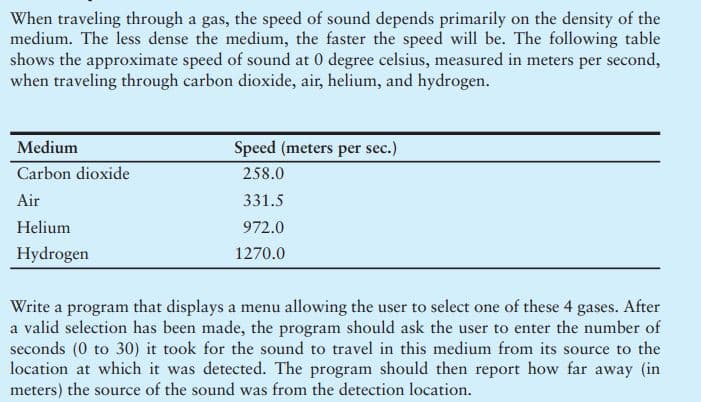When traveling through a gas, the speed of sound depends primarily on the density of the medium. The less dense the medium, the faster the speed will be. The following table shows the approximate speed of sound at 0 degree celsius, measured in meters per second, when traveling through carbon dioxide, air, helium, and hydrogen. Medium Speed (meters per sec.) Carbon dioxide 258.0 Air 331.5 Helium 972.0 Hydrogen 1270.0 Write a program that displays a menu allowing the user to select one of these 4 gases. After a valid selection has been made, the program should ask the user to enter the number of seconds (0 to 30) it took for the sound to travel in this medium from its source to the location at which it was detected. The program should then report how far away (in meters) the source of the sound was from the detection location.
When traveling through a gas, the speed of sound depends primarily on the density of the medium. The less dense the medium, the faster the speed will be. The following table shows the approximate speed of sound at 0 degree celsius, measured in meters per second, when traveling through carbon dioxide, air, helium, and hydrogen. Medium Speed (meters per sec.) Carbon dioxide 258.0 Air 331.5 Helium 972.0 Hydrogen 1270.0 Write a program that displays a menu allowing the user to select one of these 4 gases. After a valid selection has been made, the program should ask the user to enter the number of seconds (0 to 30) it took for the sound to travel in this medium from its source to the location at which it was detected. The program should then report how far away (in meters) the source of the sound was from the detection location.
Programming Logic & Design Comprehensive
9th Edition
ISBN:9781337669405
Author:FARRELL
Publisher:FARRELL
Chapter4: Making Decisions
Section: Chapter Questions
Problem 15RQ
Related questions
Question

Transcribed Image Text:When traveling through a gas, the speed of sound depends primarily on the density of the
medium. The less dense the medium, the faster the speed will be. The following table
shows the approximate speed of sound at 0 degree celsius, measured in meters per second,
when traveling through carbon dioxide, air, helium, and hydrogen.
Medium
Speed (meters per sec.)
Carbon dioxide
258.0
Air
331.5
Helium
972.0
Hydrogen
1270.0
Write a program that displays a menu allowing the user to select one of these 4 gases. After
a valid selection has been made, the program should ask the user to enter the number of
seconds (0 to 30) it took for the sound to travel in this medium from its source to the
location at which it was detected. The program should then report how far away (in
meters) the source of the sound was from the detection location.
Expert Solution
This question has been solved!
Explore an expertly crafted, step-by-step solution for a thorough understanding of key concepts.
This is a popular solution!
Trending now
This is a popular solution!
Step by step
Solved in 3 steps with 1 images

Recommended textbooks for you

Programming Logic & Design Comprehensive
Computer Science
ISBN:
9781337669405
Author:
FARRELL
Publisher:
Cengage

EBK JAVA PROGRAMMING
Computer Science
ISBN:
9781337671385
Author:
FARRELL
Publisher:
CENGAGE LEARNING - CONSIGNMENT

Microsoft Visual C#
Computer Science
ISBN:
9781337102100
Author:
Joyce, Farrell.
Publisher:
Cengage Learning,

Programming Logic & Design Comprehensive
Computer Science
ISBN:
9781337669405
Author:
FARRELL
Publisher:
Cengage

EBK JAVA PROGRAMMING
Computer Science
ISBN:
9781337671385
Author:
FARRELL
Publisher:
CENGAGE LEARNING - CONSIGNMENT

Microsoft Visual C#
Computer Science
ISBN:
9781337102100
Author:
Joyce, Farrell.
Publisher:
Cengage Learning,